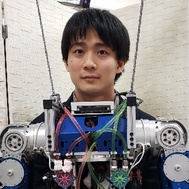Invited Talk II
9:00–10:00, Tuesday, October 25, 2022
Design and Development of Electronic Devices for Driving, Measuring and Controlling Humanoid Robots

Kunio Kojima
Graduated School of Information Science and Technology,
The University of Tokyo
Abstract
Along with the development of electronic devices such as integrated circuits, a variety of robots have been developed, including industrial robots. Our laboratory has developed musculoskeletal humanoids, high-power humanoids, flexible fleshy humanoids, and flying robots. We have studied intelligent robotic behavioral systems, dynamics control of whole-body motions, and hardware configuration of robotic physical structures for the purposes of daily life support, disaster rescue support, industrial manpower saving, and analysis of the body-intelligence mechanism. Since humanoid robots are independent machines, circuits, and systems, various issues such as weight, size, durability, as well as power consumption and processing performance, are involved with each other. Therefore, we have developed circuit devices such as power and sensor devices and inter-device communication boards while enhancing and adding functions required for actual robot applications. This presentation will introduce some of the topics in more detail and discuss the current status and future prospects.
Biography
Since 2021, Kunio Kojima has been a research associate at the Graduate School of Information Science and Technology at the University of Tokyo, specializing in humanoid robots. He had been a JSPS Research Fellowship for Young Scientists (DC1) since 2015 and received his PhD in 2018 under Professor Masayuki Inaba at the University’s Graduate School of Interdisciplinary Information Studies, where he was a project research associate. His research interests include dynamic whole-body motions by humanoid robots such as running, jumping, and sports, and he has been involved in research on robot mechanical structure design and trajectory planning and control. The humanoid robot JAXON, which he designed and built, is characterized by its motion performance equivalent to that of humans using motors and drivers designed and manufactured in his laboratory, and participated in the DARPA Robotics Challenge, an international competition for disaster rescue robots. The achievements of the first JAXON and its successors have been widely recognized nationally and internationally, receiving the Mike Stilman Award in Humanoids2019 and The Robotics Society of Japan 35th Best Paper Award, among others.